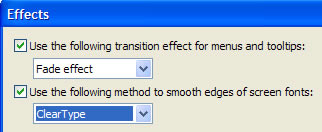Monitors and Meniere's!
Having trouble with a monitor which aggravates your symptoms? Try these to see if they help.
* Turn on Clear Type
* Increase the monitors refresh rate
* Common sense
There are two types of screen CRT- the older bulkier ones and TFT/LCD the flat screen thin ones. The problem is almost always related to CRT's so if you use this kind of monitor and can afford to invest in a TFT...or borrow one ...or use one at a local library you may well find fewer problems. The technology for displaying images is different on TFT/LCD so the problem may be reduced.
Turn on clear Type
If you are using Windows XP then turn on clear type. It's turned on by default in Vista. This can help with eye strain and make text smoother and easier to read. Microsoft guide you through doing this - Windows XP http://www.microsoft.com/typography/cleartype/tuner/Step1.aspx or

Go to your Control Panel and select Display. Click Effects. Under "use the following method" ensure this is ticked and Clear type selected.
To check it is turned on in Vista http://vistasupport.mvps.org/turn_on_off_cleartype.htm
Increase the monitors refresh rate
Especially relevant to CRT . To display images the computer is set to refresh the screen, with every refresh the image is completely redrawn but it happens so fast we can't see it but our brains do! The refresh rate is measured in Hz (hertz) and if you increase the Hz you decrease the flicker. You can adjust this by accessing your monitors settings
How to do this in XP , in Vista or in Windows 98/ME
The VESA standard states that the minimum refresh rate to avoid eye strain is 72 Hz (CRT). If you find your monitor set to 60 you should benefit from increasing higher- 60 used to be what Windows default setting was so aim for 72-75 or 85. 60 is common in laptops / TFT / LCD as refresh rates are lower due to technology differences, so these and less likely to need adjusting ; these screens should not flicker as CRTs do. Depending on your set up depends how high you can increase this to, or if you even can so always check your Manufacturers website or do some research on he net.
Common Sense
Most people say the obvious - use the computer for short periods with frequent breaks. Not easy if your job relies on using a screen all day! The other contributing problem could be glare for which you can buy a filter. Some vestibular rehabilitation exercises use computer screens to bring on mild vertigo, with a view to building up tolerance levels to using one.
This web site has been written and developed by Alex Tye - "MrLexy" on the internet!
http://www.mrlexy.co.uk. Please feel free to contact me with my feedback form.
|

